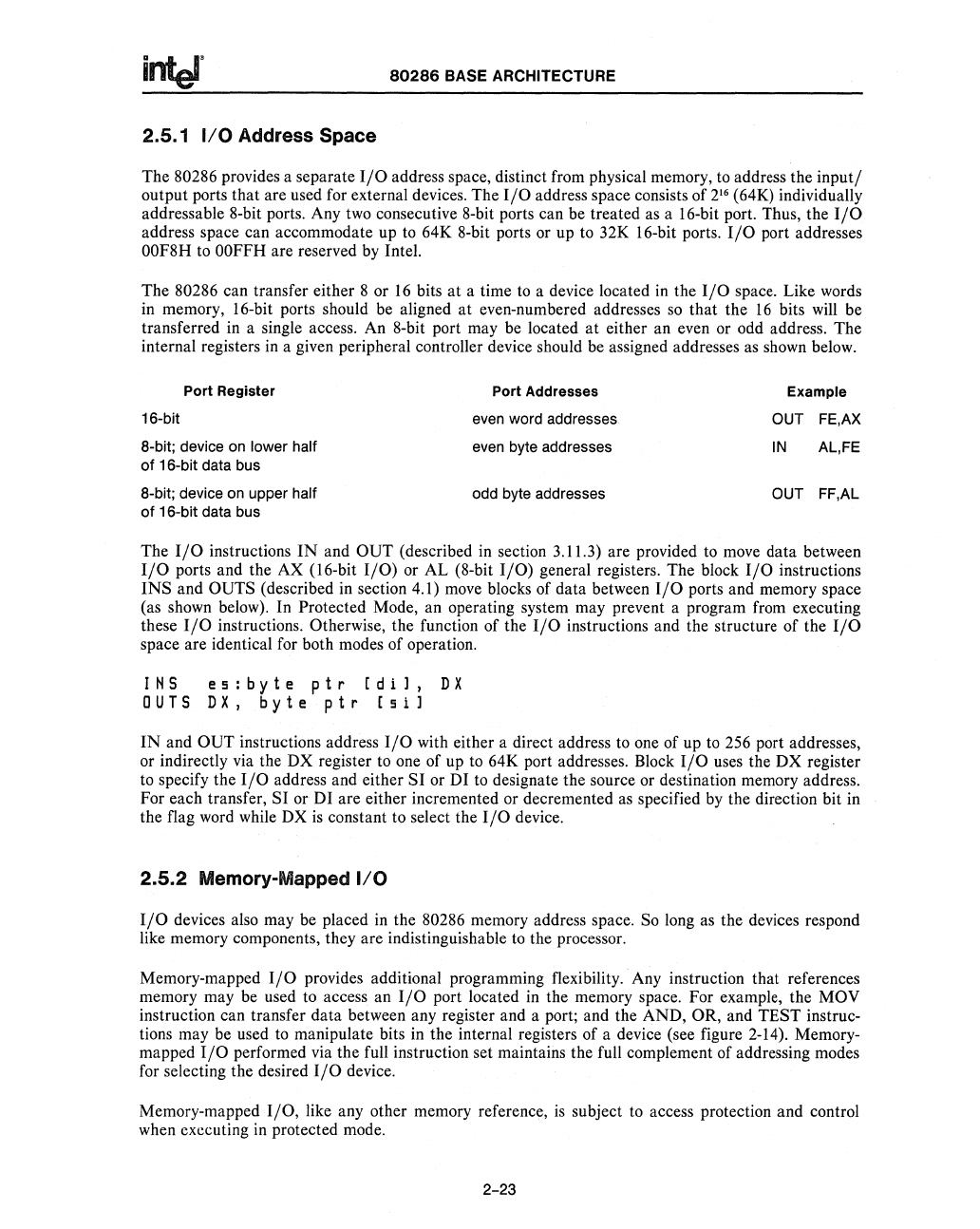
80286
BASE ARCHITECTURE
2.5.1
1/0
Address Space
The 80286 provides a separate
I/O
address space, distinct from physical memory, to address the
input/
output ports that are used for external devices. The
I/0
address space consists of 2
16
(64K) individually
addressable 8-bit ports. Any two consecutive 8-bit ports can be treated as a 16-bit port. Thus, the
I/0
address space can accommodate up to 64K 8-bit ports or up to 32K 16-bit ports.
I/0
port addresses
00F8H
to
OOFFH
are reserved by Intel.
The 80286 can transfer either 8 or
16
bits at a time
to
a device located in the
I/O
space. Like words
in memory, 16-bit ports should be aligned at even-numbered addresses
so
that the
16
bits
will
be
transferred in a single access. An 8-bit port may be located at either an even or odd address. The
internal registers
in
a given peripheral controller device should be assigned addresses
as
shown below.
Port
Register
Port Addresses
Example
16-bit
even word addresses
OUT FE,AX
a-bit; device on
lower half
even byte addresses
IN
AL,FE
of
16-bit data bus
a-bit; device on upper
half
odd byte addresses
OUT FF,AL
of
16-bit data bus
The
I/0
instructions
IN
and OUT (described in section 3.11.3) are provided to move data between
I/0
ports and the AX (l6-bit
I/O)
or AL (8-bit
I/O)
general registers. The block
I/O
instructions
INS
and OUTS (described in section 4.1) move blocks of data between
I/0
ports and memory space
(as shown below). In Protected Mode, an operating system may prevent a program from executing
these
I/0
instructions. Otherwise, the function of the
I/0
instructions and the structure of the
I/0
space are identical for both modes of operation.
INS
OUTS
es:byte
ptr
[dil,
DX,
byte
ptr
[sil
D X
IN
and OUT instructions address
I/O
with either a direct address to one of up
to
256 port addresses,
or indirectly via the DX register to one of up to 64K port addresses. Block
I/0
uses the
DX
register
to specify the
I/0
address and either
SI
or DI to designate the source or destination memory address.
For each transfer,
SI
or DI are either incremented or decremented
as
specified
by
the direction bit in
the flag word while DX
is
constant to select the
I/0
device.
2.5.2 Memory-Mapped
1/0
I/0
devices also may be placed in the 80286 memory address space. So long
as
the devices respond
like memory components, they are indistinguishable
to
the processor.
Memory-mapped
I/0
provides additional programming flexibility. Any instruction that references
memory may be used to access an
I/0
port located in the memory space. For example, the MOY
instruction can transfer data between any register and a port; and the AND, OR, and TEST instruc-
tions may be used to manipulate bits in the internal registers of a device (see figure 2-14). Memory-
mapped
I/0
performed via the full instruction set maintains the full complement of addressing modes
for selecting the desired
I/0
device.
Memory-mapped
I/O,
like any other memory reference,
is
subject to access protection and control
when executing in protected mode.
2-23


















